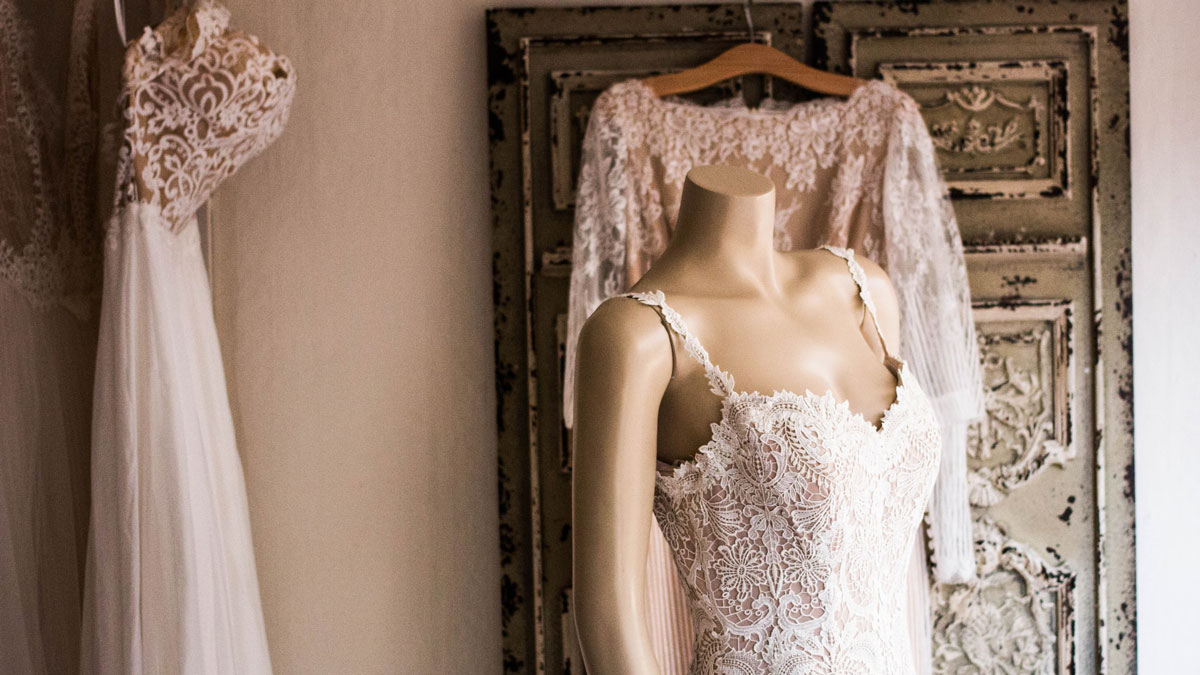Knowing how to store a wedding dress before the wedding is vital to ensure the fabric remains pure white like when you’ve bought it.
Most brides buy their gowns at least half a year before the big day to allow enough time for alterations.
While half a year may be a short time for wedding planning, that’s enough for fabric staining, creasing, and mold growth to ruin your gown.
Wedding dresses tend to be expensive and carry symbolic value, so you don’t want to risk storing yours in a plastic bag in the basement.
Correct wedding dress storage ensures it will preserve its original state and need only minor preparations for the big day, such as ventilation and steaming.
Table of Contents [show]
Get Rid of Plastic
Many wedding dresses are packed in plastic when you bring them from the bridal salon, so this point may seem counterintuitive.
However, the golden rule of wedding dress preservation states – no plastic if you plan to store the dress for longer than a few days. On the one hand, plastic helps keep dirt and dust away from your gown, so why remove it?
On the other hand, plastic doesn’t allow the fabric to breathe and breaks down under direct sunlight, causing fabric staining due to emitted gases.
One may argue that plastic won’t break down in a couple of months, but it breaks down constantly even if we don’t see it.
Plus, some dresses come in biodegradable plastic bags that break down entirely in three to six months. Although such bags are better for the environment, they’re potentially even more harmful to your dress.
A cloth garment bag offers much better protection for your dress. If you don’t have a garment bag or your gown is too voluminous to fit in, you can use an ordinary cotton sheet.
To Hang or Not to Hang
The trickiest question in wedding gown preservation is to hang or not to hang because there is no universal answer. This depends on your gown’s design and fabric.
Wedding dresses from lightweight fabrics like chiffon, organza, tulle, and lace can be hung up to prevent wrinkling.
Note that this only applies to dresses without heavy embellishments or extremely voluminous, layered skirts.
Choose your hanger wisely. Avoid narrow plastic hangers that may break under the dress’s weight (after all, even unadorned wedding gowns weigh more than most casual clothes) and may damage the shoulder construction.
Instead, choose a sturdy, wide hanger without rough edges that may damage the delicate fabric. Preferably, it should be wooden or wrapped in velvet rather than plastic and have notches or hooks to secure the dress’s hanger loops.
You can hang your dress by the hanger loops if it’s strapless. Alternatively, you may use a trouser hanger, but only if the clips don’t have sharp edges. Otherwise, they may damage your dress’s fabric.
After hanging your dress, place it in a garment bag or put a cotton sheet over it. Many brides wonder how to hang a wedding dress with a train. The best way is to use a hanger with a horizontal bar and fold the train over it if it’s long enough.
Alternatively, hang your dress in a breathable garment bag, and don’t worry about wrinkling. However, make sure the train doesn’t touch the ground.
Wedding dresses from medium to heavy fabric such as Mikado and crepe aren’t suitable for hanging. The same applies to gowns with rich embellishments and layered skirts, so nearly any ball gown falls into this category.
Such dresses should be stored flat in a box. The best wedding dress storage box should be large enough to accommodate your dress folded in two-three layers.
Here’s how to pack a wedding dress in a box – first, remove any plastic from your gown and take it off the hanger. Then, zip or button any closures on the bodice to preserve its construction unchanged.
Choose a cardboard wedding dress storage box over plastic, but make sure the lid closes properly. Place your dress in the box and layer all folds with acid-free tissue paper to prevent staining and creasing.
Start by layering the bottom of the skirt first. Leave the bodice on the top. Slide a few paper sheets inside the bodice. Finally, cover the dress with tissue paper and close the box lid, ensuring no gaps are left.
Climate Control
The correct climate is vital to preserving your wedding gown in its initial state. Ideally, you should store it in the same environment you feel comfortable in, but this doesn’t mean your dress should travel to the Bahamas.
Choose a room with a moderately warm temperature and dry air.
Avoid basements, attics, and other damp, cold places, because increased humidity may lead to mold growth and fabric staining. Never store your dress under direct sunlight, as it may change the color.
Using a dehumidifier is a good idea even if you’re storing your dress in your own room, especially if you live in a coastal region. You can get them cheap in any home store.
Prevent Odd Odors
Fabric tends to absorb odors, and you certainly don’t want your dress to have moldy or other unpleasant scents. Therefore, keep your gown away from old clothes and damp areas, and remove the plastic bag that emits odd odor when degrading.
Sometimes, wedding dresses have an odd odor right out of the bridal salon. A wedding dress’ fishy smell may be caused by chemicals used during transportation. The treatment protects the gown from dampness and insects.
In other cases, a strange wedding dress smell is related to dry cleaning. It’s common when dry cleaners use old solvents. Furthermore, dry cleaners often put garments in one pile, and they can pick up each other’s odors.
Either way, any odor should vanish if you place your dress in a ventilated room. Never pack your wedding dress in a box or garment bag if you sense an odd smell because it won’t fade in a closed space.
So, hang your dress somewhere on the balcony or near a window, but only if the weather isn’t humid. Keep it away from direct sunlight. Check the dress in a couple of hours to see if the odor has vanished.
After packing your dress, you may use wardrobe fragrances to ensure it smells nice on your big day. Such scents are available in sachets, small bags, or wooden blocks and a wide array of aromas, from fresh linen to luxury perfumes.
Resist the Temptation
Wedding is among the most exciting events of every woman’s life, so being impatient is normal. You may want to look at your dress often, but resisting the temptation is vital to preserving it in the best possible condition.
Each time you handle your dress, you risk staining it. Even if your hands are seemingly clean, you may leave sweat, deodorant, makeup, or oil marks that will only show up as yellow spots over time.
Furthermore, you will need to repeat the entire wedding dress packing process all over again every time you take it out.
Of course, sometimes, taking out the dress is necessary. If you need alterations or practice dancing in the dress, there’s no harm in taking it out, but don’t handle it frequently and remove any makeup and deodorant beforehand.
How to Get the Dress Ready for Your Big Day
Whether your dress has been stored for a few weeks or a year before the big day, it will likely be wrinkled despite all your efforts, like layering it with tissue paper. Getting rid of the wrinkles correctly is vital.
Don’t iron your dress on the maximum temperature like you iron a cotton shirt, as wedding gowns are typically made from delicate fabrics that are susceptible to heat damage. Furthermore, some fabrics can’t be ironed or steamed at all.
First, carefully inspect the dress’s label for care instructions. If the label states no ironing, hang it on a sturdy, wide hanger without any storage bag in a ventilated space.
Usually, the wrinkles vanish after a few hours to a day of hanging, depending on the fabric and how long the dress was in a box. But if some stubborn wrinkles don’t go away, hang your gown in the bathroom while a hot shower is running.
Alternatively, you may hang it above a bathtub filled with hot water but ensure the fabric doesn’t get wet. The steam should remove the most relentless wrinkles, but consider bringing your dress to local dry cleaners if it doesn’t.
If the label allows ironing, it should also indicate suitable settings. If you see an iron icon with one dot, you should only use the lowest heat setting.
Two dots indicate the fabric can handle medium heat and three that you can use the maximum heat setting. You can safely steam your dress if you see lines underneath the iron icon.
When using a steamer, start with the lowest setting and only increase the steam if the wrinkles don’t disappear. Place a cotton sock over the steamer head to prevent fabric staining and heat damage, and use distilled water.
If you’ve noticed any stains on your dress, don’t attempt to clean them yourself, especially if it’s a makeup stain. You will only rub the spot into the fabric and make it more persistent.
Bring your dress to the local dry cleaners, but make sure they don’t use the polyethylene carbonate (PEC) solvent, as it may permanently damage delicate fabrics like silk.



















No Comments Add one
Leave a Comment